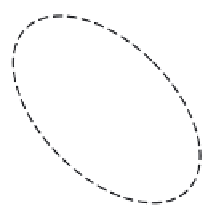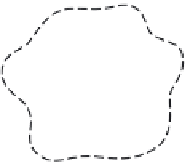Graphics Reference
In-Depth Information
4.1.4 The Idea of Diffusion
Multiple scattering gets very complex if each collision inside the medium is
traced. A simpler model arises from the more global view of the surface as a
participating medium. The key insight comes from the 1984 volume rendering
paper by Kajiya and von Herzen. As described in Chapter 3, the solution method
described in that paper comes from the empirical observation that a high degree
of scattering tends to make the scattering more isotropic. Intuitively, if there is a
lot of scattering in the medium, then light particles frequently collided with scat-
tering elements. This has the effect of smoothing out the scattering
(
Figure 4.3
)
and reducing the directionality. This is one form of the phenomenon known as
diffusion
.
Diffusion is a general physical phenomenon that occurs whenever one medium
is spread throughout another by collisions or random motion. It can be observed
not only in light scattering but also in other situations where a region is filled
with high-density particles. For example, when a drop of liquid coloring is put
in a glass of water, the color spreads through the liquid to create a uniform color
within a few minutes. This is caused in part by collisions between pigments in the
coloring and water molecules.
The process of diffusion can be described with the
diffusion equation
,which
is known to have solutions under appropriate boundary conditions. In 1995, Jos
Stam proposed modeling multiple scattering as a diffusion process and provided a
solution to the resulting diffusion equation [Stam 95]. Although his approach had
theoretical significance, the solution was based on a system of differential equa-
tions and was not very practical at the time. A 2001 paper by HenrikWann Jensen,
Stephen R. Marschner, Marc Levoy, and Pat Hanrahan introduced a technique for
approximating the diffusion equation solution without solving the system of dif-
ferential equations. It works by approximating the effect of multiple scattering in
Scattering before diffusion
Scattering after diffusion
Figure 4.3
Scattering as a diffusion process.











































